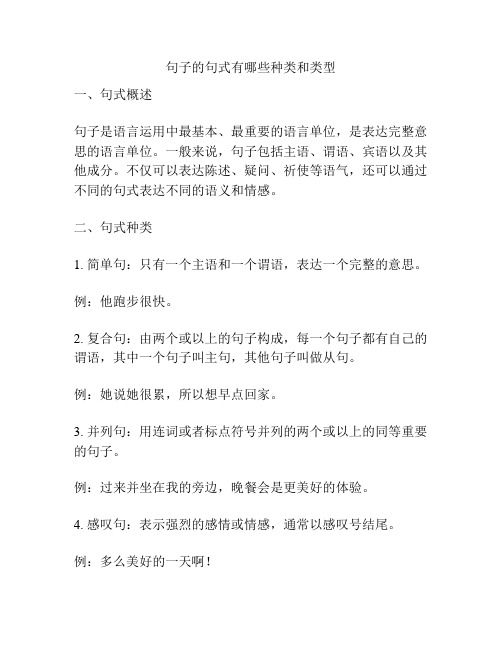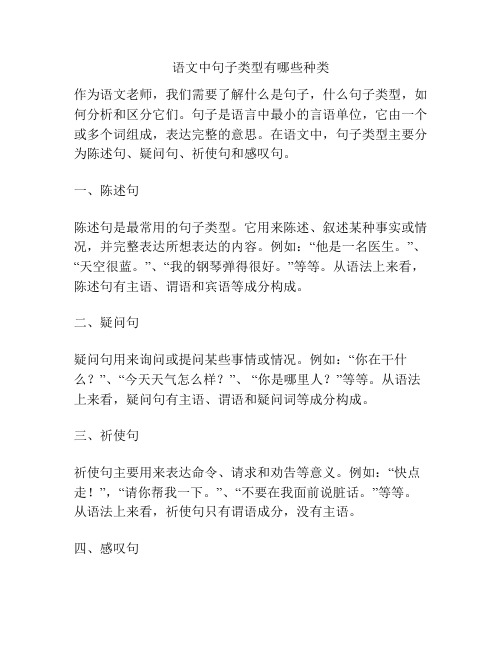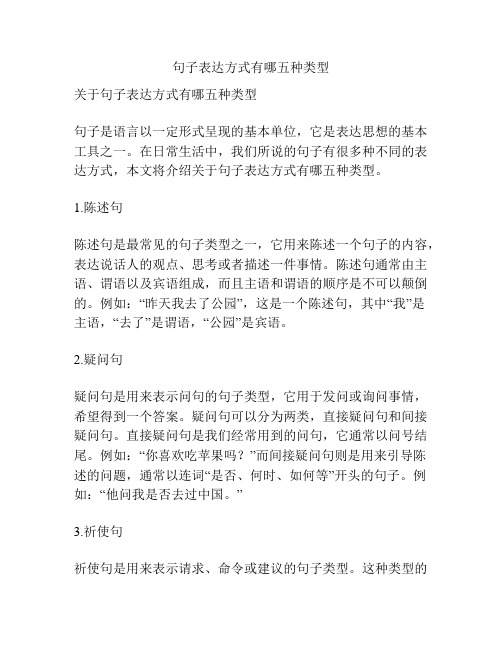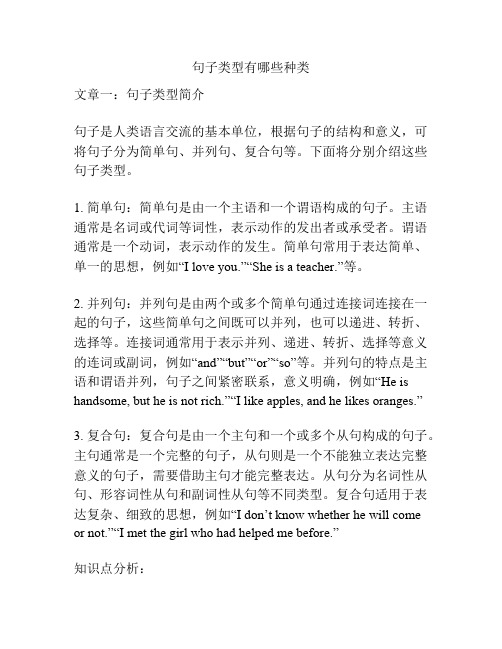句子的种类
句子的种类

Exercise:
1 -____ will you stay in Shenzhen
for your holiday? (07广东)
-For about two weeks.
A. How often
B. How long
C. How soon
D. What time
2 -____ do you usually fly kites? -In the park. (07北京)
句子的种类 (一)句子按使用目的可分为:
陈述句、疑问句、祈使句、感叹句
1)陈述句是说明一种事实或表达一 种看法。
(陈述句包括肯定句和否定句)
Light travels faster than sound. 光比声传播速度快。(说明事实)
The film is very boring. 这部电影很乏味。(说明看法)
4 -____ do you live from your school ?
-About ten minutes’ walk.( 07济宁)
A. How many
B. How long
C. How far
D. How soon
5 -____ are the Olympic Games held ?
11. His father went to work on foot yesterday.
_H_o_w__ _d_i_d__ his father __g_o__ to work yesterday?
12. Today is Thursday and tomorrow is July 1.
W__h_a_t_ _d_a_y__ is today and W__h_a_t’_s the _d_a_te__ tomorrow?
句子有哪几种句式

句子有哪几种句式句子是我们日常生活中表达思想的基本单位,是语文学习中必须要掌握的基础知识。
在语文学习中,句子的种类很多,而句子的语义和表达方式则由句式构成。
因此,在学习语文时需要掌握不同句式的用法。
下面,我们将了解句子的基本种类和三种常见的句式。
一、句子的基本种类根据句子的结构和用途,可以将句子分为四种基本类型:1.陈述句:陈述句用来陈述一个人、事、物的情况和性质,是最常用的句子类型。
例如:昨晚我看了一部关于环保的电影。
2.疑问句:疑问句用来表达疑问或询问,目的是获取信息。
例如:你爱吃西瓜吗?3.感叹句:感叹句用来表达情感或强调,强调者情感的强烈。
例如:太棒了!我们考试全班第一!4.祈使句:祈使句用来表达请求、命令或劝告。
例如:快快进入教室准备上课。
二、三种常见的句式1.主谓句主谓句是最简单的一种句式,也是最基本的句式。
它的构成由主语和谓语构成,主语用来表达句子所要描述的人、事、物,谓语则用来表达人、事、物的性质和情况。
例如:小狗跑得很快。
在这个例子中,“小狗”是主语,“跑”是谓语,构成了一个简单的主谓句。
2.主谓宾句主谓宾句是一个由主语、谓语和宾语构成的句子。
主语表示句子所要描述的人、事、物,谓语表示人、事、物的情况和性质,而宾语则表示动作的承受者。
例如:我今天吃了一个苹果。
在这个例子中,“我”是主语,“吃”是谓语,“苹果”是宾语,构成了一个主谓宾句。
3.并列句并列句是由两个或多个并列的句子组成的复杂句子。
它们之间用逗号或者连词连接。
在并列句中,每个句子都可以独立存在。
例如:我喜欢吃苹果,但是我也喜欢吃香蕉。
在这个例子中,“我喜欢吃苹果”和“我也喜欢吃香蕉”是两个并列的句子,用“但是”连接,构成了一个并列句。
总之,在学习语文的过程中,了解句子的种类和句式是必不可少的。
只有掌握好句子的基本结构和用法,才能够更好地表达自己的思想和观点。
句子的种类

1.陈述句:分为,用来陈述一个事实或者说话人的看法的句子。
肯定句:We can go to Shanghai tomorrow. 我们明天可以去上海。
否定句:We can not go to Shanghai tomorrow.我们明天不可以去上海。
2.疑问句:分为,表示提出问题、询问情况的句子。
团一般疑问句:可以简单用yes 或no 来回答的问句。
Are you Amy? ---Yes, I am./ ---No, I am not.Do you have a pen? ---Yes, I do./ ---No, I do not.团特殊疑问句:不用yes 或no 来回答,而是问什么答什么。
What time is it?---It’s 7 o’clock.How are you?---I am fine, thanks.团选择疑问句:说话人发问时为对方提供了多个选项(用or 连接),答者回答是只需做选择即可。
Which do you like, tea or coffee? ---Coffee, please.团反意疑问句/附加疑问句=1 个陈述句+1 个一般疑问句。
※前肯后否:---You are so happy, aren’t you?你很幸福,不是吗?---Yes, I am.对,我很幸福。
No, I am not.不,我不幸福。
※前否后肯:---You are not so happy, are you?你不太幸福,是吗?---Yes, I am.不,我很幸福。
No, I am not.对,我不幸福。
3. 感叹句:表达喜、怒、哀、乐及惊奇、惊讶等强烈感情的句子。
What+a/an+形容词+名词+ (主语+谓语) !What a nice girl(she is)! How+形容词+a/an+名词+ (主语+谓语) !How nice agirl (she is)!How+形容词/副词+(主语+谓语) !How beautiful (flowers are)!/How hard (he is)!4.祈使句:表示请求、命令、劝告、祝愿或建议的句子。
句子的种类有哪些类型

句子的种类有哪些类型句子是语言中的基本单位,它是表达思想和交流信息的最小结构。
在汉语中,根据句子的结构和作用,可以将句子分成多种类型。
本文将介绍句子的种类以及各自的特点与例子。
一、陈述句陈述句是表达陈述信息的句子,陈述句可以用来描述、说明、阐述具体事件、人物、物品等。
陈述句的语调基本上是下降语调。
陈述句通常是以主谓宾为结构。
例如:“小明在学校学习。
”这是一个简单的陈述句,它描绘了小明正在学校学习的场景。
二、疑问句疑问句是用来提出问题或询问对方的意见、看法,要求对方回答的句子。
疑问句的语调一般是上升语调。
疑问句有多种类型,包括一般疑问句、特殊疑问句、反义疑问句等。
例如:“你是不是想参加明天的比赛?”这是一个反义疑问句,询问对方是否有意愿参加明天的比赛,并带有肯定或否定的意思。
三、祈使句祈使句是表达命令、请求、劝告等意义的句子。
祈使句的语气比较强烈,语调是降调。
祈使句可以用来表达请求、劝告、警告等情况,例如:“快点起床!”这是一个简单的祈使句,表示对方需要尽快起床。
四、感叹句感叹句是表达感叹、惊讶、喜悦、失望等情感的句子。
感叹句的语气比较强烈,常常使用感叹词来强调情感。
例如:“多么美好的天气啊!”这是一个简单的感叹句,表示对天气美好感到惊讶和喜悦。
五、并列句并列句是由两个或多个具有相同等级关系的句子组成的复合句。
并列句的句子之间用连词连接,有时可以省略连词。
例如:“我喜欢跑步,他喜欢游泳。
”这是一个简单的并列句,表示两个句子之间的关系是平等的。
六、复合句复合句是具有主句和从句的句子。
从句分为名词性从句、形容词性从句和副词性从句。
复合句可以用来表达复杂的语义信息,常常用于描述事件的因果关系、条件、转折、让步等。
例如:“我去看电影,因为我喜欢看电影。
”这是一个简单的复合句,表示主句和从句之间有因果关系。
总之,句子是表达思想和交流信息的基本单位,具有多种类型。
不同的句子类型有着不同的特点和用法,可根据具体情境来选择使用。
句子种类有哪些类型

句子种类有哪些类型
一、句子的定义
句子是由主谓结构构成,具有自主意义,能够表达完整意思的语言单位。
二、句子的分类
1.简单句:只由一个主语和一个谓语构成的句子,是最基本的
句子类型。
例:他爱跑步。
2.复合句:两个或多个句子通过连接词、关联词、状语等连成
的完整意思的句子。
例:他喜欢唱歌,但是不擅长跳舞。
3.并列句:两个或多个具有相互独立、平行关系的句子,通过
连接词、标点等连成的句子。
例:小明爱运动,小芳爱音乐,他们都是好朋友。
4.复杂句:由主句和一个或多个从句构成的句子,包括名词性
从句、形容词性从句和副词性从句。
例:我听到他说他要努力学习,很感动。
5.疑问句:表达疑问的句子,分为一般疑问句、特殊疑问句、
反义疑问句。
例:你是学生吗?
三、句子分类的重要性
正确分类句子有助于我们正确理解别人说话的意图。
在写作中,掌握句子的分类,能够帮助我们构建更好的句子,并且使文章更加通顺、连贯。
四、句子分类的注意事项
1.语气:不同的句子分类会表达不同的语气,如陈述、疑问、命令等。
2.主谓结构:句子构成的基础是主谓结构,所以正确理解主谓结构对于正确分类句子是非常重要的。
3.从句位置:复杂句的分类需要注意从句的位置,以正确理解从句的功能。
五、结语
句子分类有利于我们更好的理解和表达语言,正确分类和使用句子类型能够提高文章质量,进一步提升个人言语表达和写作能力。
句子的种类介绍精选全文完整版

可编辑修改精选全文完整版句子的种类介绍句子的种类介绍(一)按使用目的可分为陈述句、疑问句、祈使句和感叹句。
1)陈述句(Declarative Sentences):说明一个事实或陈述一种看法。
Light travels faster than sound. 光比声速度快。
(说明事实)The film is rather boring. 这部电影很乏味。
(说明看法)2)疑问句(Interrogative Sentences):提出问题。
有以下四种:a. 一般疑问句(General Questions):Can you finish the work in time?你能按时完成工作吗?b. 特殊疑问句(W Questions; H Questions):Where do you live? 你住那儿?How do you know that? 你怎么知道那件事?c. 选择疑问句(Alternative Questions):Do you want tea or coffee?你是要茶还是要咖啡?d. 反意疑问句(Tag-Questions):He doesn't know her, does he?他不认识她,对不对?3)祈使句(Imperative Sentences):提出请求,建议或发出命令,例如:Sit down, please. 请坐。
Don't be nervous! 别紧张!4)感叹句(Exclamatory Sentences):表示说话人惊奇、喜悦、愤怒等情绪,例如:What good news it is! 多好的消息啊!(二)句子按其结构可以分为以下三类:1)简单句(Simple Sentences):只包含一个主谓结构句子叫简单句,例如:She is fond of collecting stamps. 她喜欢集邮。
(主) (谓)2)并列句(Compound Sentences):包含两个或两个以上主谓结构的句子叫并列句,句与句之间通常用并列连词或分号来连接,例如:The food was good, but he had little appetite.(主) (谓) (主)(谓)食物很精美,但他却没什么胃口。
语文句子种类有哪些词语

语文句子种类有哪些词语句子是语言表达的基本单位,它包含了语言意义的最小完整片段,所以在语文学习中很重要。
句子种类是指根据语法结构和词语的组合形式,将句子分成不同的类型,有利于学生掌握和应用语言。
一、陈述句陈述句是用来陈述事实、阐述观点或叙述事件的一种句子。
它通常可以通过语气的上升或下降来区分,由主语和谓语构成,例如:我喜欢吃水果。
分析:1、陈述句最常用的句式是主语+谓语+宾语,如:爸爸去买菜了。
2、适合在叙述事件或陈述事实的文章中使用。
3、陈述句也可以用在掩饰自己情绪的语境中,例如:我没事儿。
4、灵活运用陈述句可以使文章更加自然流畅,避免过度夸张和虚构。
二、疑问句疑问句是用来提问、询问、表达疑虑和不确定性的一种句子。
它通常以疑问词开头,例如:你喜欢什么颜色?分析:1、疑问句通常以疑问词开头,例如“谁”、“什么”、“哪里”、“怎么样”等。
2、疑问句主要用于提问和表达疑问,可以帮助了解事实真相或获取信息。
3、使用疑问句可以使文章更具有互动性,读者可以直接参与到文章中来,增强读者的阅读兴趣。
4、在使用疑问句时要注意不要过度使用,否则会给人一种不稳定、犹豫的感觉。
三、祈使句祈使句是用于请求、命令、建议和劝告等的一种句子,它通常以动词开头,例如:听一下。
分析:1、祈使句以动词开头,通常没有主语,例如:开门。
2、祈使句主要用于请求、命令、建议和劝告等方面,能够有效地影响读者。
3、使用祈使句可以给读者一种直接、强有力的感觉,能够让文章更具有说服力。
4、在使用祈使句时要注意使用适当的语气,避免词语过于严厉或生硬,影响读者的接受。
四、感叹句感叹句是用于表达感情、情绪、惊异和赞叹等的一种句子,它通常以感叹词、语气词或主语中的形容词、副词等单词作开头,例如:多么美丽的风景啊!分析:1、感叹句以感叹词或语气词开头,如:呀、嗯、哎呦等。
2、感叹句主要用于表达感情、情绪、惊异和赞叹等,能够有效地调动读者的情感。
3、使用感叹句可以使文章显得更加生动、直观,能够让读者更加投入阅读。
句子的句式有哪些种类和类型

句子的句式有哪些种类和类型一、句式概述句子是语言运用中最基本、最重要的语言单位,是表达完整意思的语言单位。
一般来说,句子包括主语、谓语、宾语以及其他成分。
不仅可以表达陈述、疑问、祈使等语气,还可以通过不同的句式表达不同的语义和情感。
二、句式种类1. 简单句:只有一个主语和一个谓语,表达一个完整的意思。
例:他跑步很快。
2. 复合句:由两个或以上的句子构成,每一个句子都有自己的谓语,其中一个句子叫主句,其他句子叫做从句。
例:她说她很累,所以想早点回家。
3. 并列句:用连词或者标点符号并列的两个或以上的同等重要的句子。
例:过来并坐在我的旁边,晚餐会是更美好的体验。
4. 感叹句:表示强烈的感情或情感,通常以感叹号结尾。
例:多么美好的一天啊!5. 祈使句:表示请求、命令、劝告等,通常以动词原形开头。
例:把书拿给我。
三、句式类型1. 简单句类型断言句、疑问句、祈使句2. 复合句类型主从句类型、并列句类型、间接引语类型3. 平衡句类型对偶句、三段论句、反问句4. 比较句类型比喻句、拟人句、对比句5. 描述句类型描绘句、夸张句、概括句四、句式分析句子分析是语言学分析的一个分支,在文学、语言学市场中都有重要的作用。
可以从以下几个方面对句式进行分析:1. 句子成分分析句子成分包括主语、宾语、谓语、定语、状语、补语等。
分析句子成分可以帮助我们更好地理解句子的意义。
2. 句子结构分析句子结构分析指的是句子在语法上的结构形式,包括并列句、复合句、长句等。
分析句子结构有助于我们了解句子在语言中的功能和作用。
3. 句子语调分析句子语调分析指的是句子在语音上的声调和节奏。
分析句子语调可以帮助我们更好地理解句子的语感和情感。
4. 句子语言层次分析句子语言层次分析指的是句子在语言上的形式美感和文化内涵。
分析句子语言层次可以帮助我们更好地欣赏和理解作品中的语言表达。
五、小结句式是语言表达中重要的组成部分,包括简单句、复合句、并列句、感叹句、祈使句等不同的种类和类型。
句子种类有哪些词语和句子

句子种类有哪些词语和句子作为语文老师,我将为大家阐述句子种类有哪些词语和句子的文章,并且分析其中的4个要点。
一、基本句型种类1.简单句:只包含一个主语和一个谓语,可以有其他成分,不含任何从句。
例如:小明跑了。
2.并列句:由两个或多个主语、谓语相同的简单句组成的复合句,各个部分之间用并列连词连接。
例如:小明跑了,小红也跑了。
3.复合句:又称主从句,由一个主句和一个或多个从句组成的句子。
例如:我喜欢唱歌,因为这让我感到快乐。
二、句子成分种类1.主语:句子中用来说明行为或状态的人或物体,通常以名词、代词或词组形式出现。
例如:小明跑步。
2.谓语:句子中用来说明主语行为或状态的动词或动词短语。
例如:我喜欢唱歌。
3.宾语:句子中受主语动作影响的人或物,通常以名词、代词或词组形式出现。
例如:她看见了一只小狗。
4.定语:修饰名词或代词的词或词组,一般在名词或代词前面出现。
例如:他风度翩翩的样子让人印象深刻。
5.状语:修饰动词、形容词、副词等的词或词组,表达时间、地点、方式、原因等词性。
例如:他毅然做出了决定。
三、句子的修辞手法1.比喻:用一个形象生动的事物来表示另一个事物,加深比较对象的理解。
例如:他的心如同一朵蓝色玫瑰,孤独而美丽。
2.拟人:将无生命的事物描写成有生命的形式,给人以鲜明的形象感受。
例如:风儿轻轻地从我的面颊上拂过,温柔地问候着我。
3.排比:利用互相平行的语句形式,使语言更加简洁明了、鲜明生动。
例如:学生们,让我们用心听、用眼看、用脑思,共创美好的明天。
4.反问:用疑问的方式表达肯定或否定的意思。
例如:这样的机会你舍得放过吗?四、文章的句式运用1.写景:通过对自然环境的描写来表现人物情感,采用定语和状语的修辞手法,使文章更加生动形象。
例如:夕阳下的山头,一只可爱的小松鼠在玩耍。
2.写人:通过对人物的情感、性格、语言、行为等的描述来塑造人物形象,运用比喻、拟人等修辞手法,使文章更具生动感。
例如:他的战斗精神如同勇士般顽强无畏,不屈不挠地奋斗着。
句子种类有哪些

句子种类有哪些关于句子种类有哪些句子是语言的基本单位,它是表达思想和交流信息的最基本手段之一。
而句子的种类也是语文学习的重要内容之一。
在语文学习中,掌握句子的种类对于我们正确理解语言的含义、有效地表达自己的思想都至关重要。
句子种类一般可分为简单句、复合句和并列句三类。
一、简单句简单句又称“独立结构”,是指只包含一个主语和一个谓语的句子。
例如:“小明喜欢跑步。
”“她爱看电影。
”“我出门了。
”简单句中可以含有各种修饰成分,如宾语、定语、状语等,但它们都是为了修饰主语和谓语,进一步表述句子的意思。
简单句构成简单,一般情况下表达的含义明确,是我们日常生活中最常使用的句子。
而在语文学习中,我们需要重点掌握一些特殊的简单句类型,如带有倒装语序的简单句、祈使句(命令句)、感叹句等。
二、复合句复合句是由两个或多个句子组成的句子。
它含有一个主句和一个或多个从句。
主句在复合句中起着句子核心的作用,而从句则作为主句中的一个成分来使用。
例如:“我喜欢吃苹果,因为它们味道甜美。
”这个句子中,“我喜欢吃苹果”是主句,“因为它们味道甜美”则是从句。
复合句种类繁多,有因果关系、时间关系、条件关系、让步关系等各种不同的关系,需要我们在学习中仔细区分。
掌握复合句的结构和种类,可以帮助我们更好地理解句子的含义,进一步提高我们的语文表达水平。
三、并列句并列句是由两个或多个简单句通过连接词等连接起来的句子。
它们的语义关系是并列关系,各个句子之间地位平等。
例如:“她跳得很高,他跑得很快。
”这个句子中,“她跳得很高”和“他跑得很快”两个简单句之间通过连词“而”连接起来,形成并列句。
并列句常见的连接词有“而”、“却”、“或”、“并且”等。
并列句的结构清晰简明,表达方式直接,常用于说明两个相对独立的事物。
总之,掌握不同类型的句子是语文学习的重要内容,这有助于我们更好地理解语言的含义、提高语文表达的能力。
最后,我们再通过以下三个例子进一步说明不同类型的句子。
语文中句子类型有哪些种类

语文中句子类型有哪些种类作为语文老师,我们需要了解什么是句子,什么句子类型,如何分析和区分它们。
句子是语言中最小的言语单位,它由一个或多个词组成,表达完整的意思。
在语文中,句子类型主要分为陈述句、疑问句、祈使句和感叹句。
一、陈述句陈述句是最常用的句子类型。
它用来陈述、叙述某种事实或情况,并完整表达所想表达的内容。
例如:“他是一名医生。
”、“天空很蓝。
”、“我的钢琴弹得很好。
”等等。
从语法上来看,陈述句有主语、谓语和宾语等成分构成。
二、疑问句疑问句用来询问或提问某些事情或情况。
例如:“你在干什么?”、“今天天气怎么样?”、“你是哪里人?”等等。
从语法上来看,疑问句有主语、谓语和疑问词等成分构成。
三、祈使句祈使句主要用来表达命令、请求和劝告等意义。
例如:“快点走!”,“请你帮我一下。
”、“不要在我面前说脏话。
”等等。
从语法上来看,祈使句只有谓语成分,没有主语。
四、感叹句感叹句用来表达惊奇、高兴、悔恨、惋惜等强烈的情感。
例如:“多么美好的一天啊!”、“太好了!”、“真可惜!”等等。
从语法上来看,感叹句主要由主语和谓语构成,但需要特别注意的是,感叹句的末尾需要加上感叹号。
以上是四种常见的句子类型,从中我们可以得出以下结论:1.语句的主要作用是传达信息或情感。
2.句子可以通过语序、语调和标点等方式来判断句子类型。
3.不同的语言和文化对句子类型的分类有所不同,但大多数语言都有相似的句子类型。
4.应根据句子类型的不同,采用不同的口气、语气和语态来表达相应的意义,以避免出现误解或不当的交际。
句子表达方式有哪五种类型

句子表达方式有哪五种类型关于句子表达方式有哪五种类型句子是语言以一定形式呈现的基本单位,它是表达思想的基本工具之一。
在日常生活中,我们所说的句子有很多种不同的表达方式,本文将介绍关于句子表达方式有哪五种类型。
1.陈述句陈述句是最常见的句子类型之一,它用来陈述一个句子的内容,表达说话人的观点、思考或者描述一件事情。
陈述句通常由主语、谓语以及宾语组成,而且主语和谓语的顺序是不可以颠倒的。
例如:“昨天我去了公园”,这是一个陈述句,其中“我”是主语,“去了”是谓语,“公园”是宾语。
2.疑问句疑问句是用来表示问句的句子类型,它用于发问或询问事情,希望得到一个答案。
疑问句可以分为两类,直接疑问句和间接疑问句。
直接疑问句是我们经常用到的问句,它通常以问号结尾。
例如:“你喜欢吃苹果吗?”而间接疑问句则是用来引导陈述的问题,通常以连词“是否、何时、如何等”开头的句子。
例如:“他问我是否去过中国。
”3.祈使句祈使句是用来表示请求、命令或建议的句子类型。
这种类型的句子通常省略主语,而谓语动词要用原型动词形式,例如:“走着瞧!”祈使句可以使用附带语来表达真实的意思,或使用感叹词或重音来表达强烈的情感。
4.感叹句感叹句是用来表达强烈情感的一种句子类型。
它通常用来表达惊讶、高兴、悲伤、羡慕等情绪。
感叹句通常是使用感叹词或者修辞手法来表达强烈的情感。
例如:“多么美丽的风景啊!”或者“太好了!”5.复合句复合句是用两个或以上的分句构成的,它们可以作为一个整体来表示一个完整的意思。
复合句可以分为三种类型,分别是并列句、主从复合句和简单复合句。
并列句使用连词连接两个平行的分句,例如:“他喜欢跳舞,她喜欢唱歌。
”主从复合句通常是由主句和从句构成,从句一般是一个副词子句、名词子句、形容词子句。
例如:“他说他上个星期去了中国。
”简单复合句由一个主句和一个或多个修饰从句构成。
例如:“我想知道你明天要做什么。
”总结句子作为语言的基本单位,在表达意义方面具有非常重要的作用。
句子类型有哪些种类

句子类型有哪些种类文章一:句子类型简介句子是人类语言交流的基本单位,根据句子的结构和意义,可将句子分为简单句、并列句、复合句等。
下面将分别介绍这些句子类型。
1. 简单句:简单句是由一个主语和一个谓语构成的句子。
主语通常是名词或代词等词性,表示动作的发出者或承受者。
谓语通常是一个动词,表示动作的发生。
简单句常用于表达简单、单一的思想,例如“I love you.”“She is a teacher.”等。
2. 并列句:并列句是由两个或多个简单句通过连接词连接在一起的句子,这些简单句之间既可以并列,也可以递进、转折、选择等。
连接词通常用于表示并列、递进、转折、选择等意义的连词或副词,例如“and”“but”“or”“so”等。
并列句的特点是主语和谓语并列,句子之间紧密联系,意义明确,例如“He is handsome, but he is not rich.”“I like apples, and he likes oranges.”3. 复合句:复合句是由一个主句和一个或多个从句构成的句子。
主句通常是一个完整的句子,从句则是一个不能独立表达完整意义的句子,需要借助主句才能完整表达。
从句分为名词性从句、形容词性从句和副词性从句等不同类型。
复合句适用于表达复杂、细致的思想,例如“I don’t know whether he will comeor not.”“I met the girl who had helped me before.”知识点分析:1. 通过分析不同的句子类型,我们可以了解到不同类型的句子具有不同的结构和意义,可以用于表达不同的思想和情感。
2. 简单句是最基本的句子类型,适用于表达简单的思想和动作,但无法表达复杂的连接关系;并列句则可以将多个简单句连接在一起,以达到更加丰富的表达效果;复合句则可以使用从句来表达更为复杂的连接关系,使句子更为精准和细致。
3. 句子类型的应用需要遵循语言交流的规范和习惯,根据不同的语境和目的选择合适的句子类型来表达自己的思想和情感,有效地交流和沟通。
句子都有哪些类型语文

句子都有哪些类型语文句子是语文中最基本的单位,是表达意思的最小语音单位。
句子种类的分类较多,其中较常见的有简单句、复合句、并列句和独立主格结构等,本文将详细介绍句子的种类及其用法。
一、简单句简单句是指只包含一个主语和一个谓语的句子。
简单句通常用于表达简单明了的意思或单独的陈述。
例如:1. 我喜欢唱歌。
这句话只有一个主语“我”和一个谓语“喜欢唱歌”,表达了一个简单的想法。
2. 她是个老师。
这句话有一个主语“她”和一个谓语“是个老师”,也表达了一个简单的陈述。
简单句的构成比较简单,容易理解和记忆。
例如,简单句的谓语可以是动词,形容词,名词等。
此外,简单句还可以有修饰词和宾语等成分,例如:3. 那只猫睡得很香。
这句话中的“那只猫”是主语,“睡得很香”是谓语,“得很香”是修饰词。
二、复合句复合句是由一个主句和一个或多个从句组成的句子。
主句是一个完整的句子,而从句则需要依附于一个主句来完成结构。
复合句更加复杂,语法结构也比较抽象。
例如:1. 我发现,天已经黑了。
这句话中的“我发现”是主句,“天已经黑了”是一个时间状语从句。
2. 她告诉我,她最近在学中文。
这个句子中的“她告诉我”是主句,“她最近在学中文”是一个宾语从句。
由于复合句涉及到主从句之间的关系,所以需要特别注意两者之间的引导词。
例如,引导时间、条件、目的、原因等关系的从属词如“当……时候”、“如果”、“为了”、“因为”等。
三、并列句并列句是由两个或多个具有相等地位的独立分句组成的句子,用逗号或句号分开。
并列句可以有多个主语和谓语,但它们需要同等重要或同一地位。
例如:1. 她去了加拿大,他去了澳大利亚。
这个句子中有两个并列的分句,用逗号隔开,表达了两个同等重要的情况。
2. 他喜欢打篮球,她喜欢跑步。
这个句子中也有两个并列分句,用逗号分开。
并列句在语法结构上相对简单,但需要注意的是两个分句之间的逻辑关系。
例如,两个分句可以是并列关系,也可以是转折或因果关系等。
句子的种类

简单句种类1、简单句的特点:简单句通常只由一个主语(或并列主语)和一个谓语(或并列谓语)构成。
2、简单句的种类:简单句一般分为陈述句、疑问句、感叹句和祈使句四种。
3、陈述句:用来说明一个事实的句子叫陈述句。
它有肯定式和否定式两种形式。
▲陈述句的肯定式:He is a middle school student.(他是个中学生)/ I have a hammer in my hand.(我手上有把锤子)/ She teaches us geography.(她教我们地理)▲陈述句的否定式:1)谓语动词如果是be 、助动词、情态动词时,在它们的后面加“not”。
如:My brother is not a teacher.2)谓语动词如果没有上述词语而是其他动词时,须在它的前面加do not(don’t).如:I don’t know anything about it.(此事我一无所知) / Li Ming does not feed pigs in the countryside.(李明不在农村养猪)3) have 的否定形式:1)当表示“有”的意思时,可以采用以下三种形式:have+not;do not+ have;have+ no+ n. 如:I have not enough food to eat.= I do not have enough food to eat. =I have no enough food to eat. 2)当have为助动词时,用“have+ not‖结构。
如:I have not been toShanghai。
3)当have既不表示“有”,也不作助动词用时,用“do not+ have”结构。
I didn’t have breakfast th is morning. 具体到反义疑问句中,则遵循以下原则:a.当have表示“有”含义时,反意疑部问部分可以用have形式,也可以用do形式。
句子类型有哪几种类型的

句子类型有哪几种类型的文章一:句子类型有哪几种类型句子是语言沟通的基本单位,根据不同的语法结构和表达意义的方式,句子可以分为几种不同的类型。
下面是对句子类型的分类和分析。
一、陈述句陈述句是句子中最基本的类型,它用来陈述一个事实或描述一种情感、特征等。
陈述句语序通常为主语+谓语+宾语,也有可能是主语+动词不及物。
例如,“我是一个大学生”、“她喜欢看书”都是陈述句。
二、疑问句疑问句是用来回答问题的句子,通常以疑问词(如什么、谁、哪里、怎么)开头,也可以直接反问。
疑问句语序通常为疑问词+主语+谓语+宾语。
例如,“你去了哪里?”、“今天的天气很好,不是吗?”都是疑问句。
三、祈使句祈使句是用来表达命令、请求、建议等意思的句子。
祈使句语序通常为动词或助动词+宾语(省略主语)。
例如,“请关好门”、“别做傻事”都是祈使句。
以上就是三种基本的句子类型。
当然,还有其他类型的句子,如感叹句、条件句、并列句等等。
掌握不同类型的句子可以帮助我们更精准地表达自己的意思,让语言交流更具有针对性和效果性。
文章二:句子类型和语法结构句子类型和语法结构是密切相关的。
下面将介绍几种句子类型及其语法结构。
一、陈述句陈述句是最常见的句子类型,其语法结构为主语+谓语+宾语或主语+不及物动词。
主语是指动作的执行者或承受者,谓语是指描述主语完成的动作或状态,宾语是指动作的对象或受者,不及物动词则是指主语本身就包含动作的句子。
例如,“我爱你”、“他在写文章”都是陈述句。
二、疑问句疑问句是用来问问题的句子,其语法结构多种多样,通常以疑问词(如什么、为什么、哪里等)开头。
疑问句的语法结构可以是主语+谓语+宾语+疑问词,也可以是疑问词+主语+谓语+宾语等,具体形式取决于问题的种类和构成。
例如,“你吃了什么?”、“为什么他会这样做?”。
三、祈使句祈使句用来表示希望、命令或请求,其语法结构为动词或助动词+宾语(省略主语)。
例如,“看见我时请微笑”、“让我们一起去旅行”都是祈使句。
句子的类型有多少种类

句子的类型有多少种类文章一:句子的类型有多少种类句子是语言交流的基本单位,根据语法结构和功能,句子可以分为不同的类型。
常见的句子类型包括陈述句、疑问句、祈使句、感叹句和复合句等。
了解不同类型的句子对于语言学习和表达都具有重要的意义。
知识点一:陈述句陈述句是用来陈述事实、表述观点、描述情况等的句子类型。
它通常是以陈述语气表示的,即主语在前,谓语在后。
例如:我喜欢唱歌;他是一名医生;今天天气很好。
知识点二:疑问句疑问句是用来询问信息或者确认事实的句子类型。
疑问句中通常包含一个疑问词或者疑问语气,如谁、什么、哪里、为什么等。
根据语气,疑问句又可以分为一般疑问句、特殊疑问句和反义疑问句。
例如:你喜欢音乐吗?这里是哪个城市?你不喜欢唱歌,是吗?知识点三:复合句复合句是由两个或者以上的句子组成的句子类型。
复合句中包含一个主句和一个或者多个从句,从句作为主句的一部分来构成意义完整的句子。
根据从句的种类和用途,复合句也可以分为名词性从句、定语从句和状语从句。
例如:我相信他会来的(名词性从句);那个穿蓝色衣服的女孩是我的朋友(定语从句);当我们旅行时,每天都是新的体验(状语从句)。
总结来看,句子类型包括陈述句、疑问句、祈使句、感叹句和复合句等。
掌握不同类型的句子可以帮助我们更好地表达自己的思想,更加准确地理解别人的语言表达。
文章二:分析句子类型的功能和特点句子是语言中最基本的单位,不同类型的句子有不同的语法结构和功能。
了解句子类型的规则和特点对于提高语言表达的准确性和流畅度有很大的帮助。
知识点一:陈述句陈述句是用来描述事实、表述观点或者叙述经验的最基本的句子类型。
其语气通常为陈述语气,主要特点是主语在前,谓语在后,句子结构固定。
在交流中,陈述句是用的最多的句子类型,能够帮助我们准确地表达自己的思想和观点。
知识点二:疑问句疑问句是用来询问信息或者确认事实的句子类型。
疑问句有着明显的语气特点,其主要特点是主语和谓语的语序发生了变化,同时还包含疑问词或者疑问语气。
句子的种类有哪几种

句子的种类有哪几种1. 文章一:句子的种类概述句子是语言表达中最基本的单位,可以传递出书面或口头信息。
根据不同的语法结构和表达目的,主要的句子种类有五种:陈述句、疑问句、祈使句、感叹句和条件句。
知识点一:陈述句陈述句是最基础、最常见的句式,在语言交流中最为普遍。
陈述句传达的是一种描述性的语气,即表明陈述者的看法和态度,相当于用语言刻画描绘出了某个事物或情形。
一个完整的陈述句应包括一个主语和一个谓语。
例如:“Tom is reading a book.” 即表达了Tom正在读书这一事实。
知识点二:疑问句疑问句是用来提出问题或询问某些事物的一种句型。
疑问句通常以特殊的语调或者特定的疑问词开头,比如“what”,“who”,“when”,“why”,以及“How”等。
在疑问句中,要求回答者按照提问者的意愿给出决策或回答。
例如:“What are you doing?” 这个疑问句问的是对方目前正在干什么。
知识点三:祈使句祈使句是用来表达请求、建议或命令等情感的句式。
祈使句一般表示一种命令性或者建议性,比如“Please be quiet.”或者“Start your work.”,这样的祈使句可以传递一种明确而直接的意愿,而不涉及到任何的不确定性或猜测。
2. 文章二:句子的种类详解除了五种基本的句式之外,还有一种句子类型需要介绍,那就是条件句。
条件句的作用是表达一种假设,即某个条件成立的时候,发生的事件或者其它情况。
条件句进一步分为三种:第一种是虚拟语气的第一种形式;第二种是虚拟语气的第二种形式;第三种是真实条件句。
知识点一:虚拟语气的第一种形式虚拟语气的第一种形式通常出现在虚拟条件句当中,表示一个虚拟的情况,即它没有真实发生的可能性。
这种虚拟条件句常常包含来可能不会发生的事情。
例如:“如果我生在上世纪,我就会成为一个出色的波普歌手。
” 虚拟条件既不属于现实,也不属于过去或未来,而是表示一种想象或愿望。
句式的种类

句式的种类句子的种类主要有以下几类:1. 陈述句(declarative sentence):陈述一种事实、信息或观点。
例如:The sun is shining.(太阳在照耀。
)2. 疑问句(interrogative sentence):用来询问问题。
例如:Are you coming with us?(你跟我们一起来吗?)3. 命令句(imperative sentence):用来表达命令、请求或建议。
例如:Sit down.(坐下。
)4. 感叹句(exclamatory sentence):用来表达强烈的情感或感叹。
例如:What a beautiful sunset!(多美丽的日落啊!)5. 祈使句(exhortatory sentence):用来表达劝告、请求或建议。
例如:Please be careful.(请小心。
)6. 条件句(conditional sentence):根据某种条件来表达可能性或假设。
例如:If it rains, we will stay inside.(如果下雨,我们就呆在屋里。
)7. 并列句(compound sentence):由两个或多个独立的子句组成,通过连接词(如and、but、or)来表示它们之间的关系。
例如:I like to read, and my sister enjoys painting.(我喜欢阅读,我妹妹喜欢绘画。
)8. 从句(dependent clause):包含一个主语和一个谓语,但不能独立成句,需要依赖其他分句。
例如:After I finish my homework, I can go out to play.(我一完成作业,就可以出去玩了。
)这些是常见的句子种类,根据不同的语境和用途,句子可以有更多的变化形式和类型。
- 1、下载文档前请自行甄别文档内容的完整性,平台不提供额外的编辑、内容补充、找答案等附加服务。
- 2、"仅部分预览"的文档,不可在线预览部分如存在完整性等问题,可反馈申请退款(可完整预览的文档不适用该条件!)。
- 3、如文档侵犯您的权益,请联系客服反馈,我们会尽快为您处理(人工客服工作时间:9:00-18:30)。
句子的种类
The Types of Sentences
By Zhang Yunwang On Sunday, December 07, 2014
1.英语的句子按照用途可分为以下四类
陈述句
肯定句:This is a book.He likes music.
否定句:It isn’t a bird.He doesn’t like music. 一般疑问句:Is it a bag? Does she like noodles?
感叹句
以How 开头的感叹句:How beautiful it is!
(1). 陈述句 用来说明事实或说话人的看法,句末有句号。 e.g. My name is Kate. I think it’s exciting. 1). 陈述句的词序
主语+谓语动词(+宾语)
主语+连系动词+表语
e.g. I like coffee.
疑问句 句子类型问句:Is it a bird or a plane?
反问句:e.g.This is a nice picture,isn’t it?
肯定句:Go there! Let’s go! 否定句:Don’t go there! 以What 开头的感叹句:What a beautiful flower it is!
一般是指用yes或no回答的疑问句。
基本结构为: 助动词/情态动词+主语+…… 也就是说将 陈述句的第一个助动词(be或will,have,has)或情态动词(can)提 至主语之前;如:
He is a teacher.------------ Is he a teacher?(一般现在时) He was a worker.----Was he a worker? (一般过去时) He is going to be a doctor.---- Is he going to be a doctor? (一般将来时)
如果句子中的谓语动词为be动词,变为否定结构时,将否 定词not置于be动词之后,如: He is a teacher.------------He is not (isn’t) a teacher.(一般 现在时) He was a worker.----He wasn’t a worker.(一般过去时) He is going to be a doctor.---- He isn’t going to be a doctor .(一般将来时) He is reading a story book.---- He isn’t reading a story book.(现在进行时)
He is reading a story book.---- Is he reading a story book? (现在进行时) He will go home.---- Will he go home?(一般将来时) She can play the piano.---- Can she play the piano?(情态动 词) She has got a story book.---- Has she got a story book?(has got结构) I’ve got a stamp from Canada.----Have you got a stamp from Canada?(have got 结构,I---you)
She has got a story book.---- She hasn’t got a story book.(has got结构)
I’ve got a stamp from Canada.----I haven’t got a stamp from Canada.(have got 结构)
(2) 疑问句 用于提问的句子叫做疑问句。疑问句句末需用问号。疑问句 有一般疑问句、特殊疑问句、选择疑问句、附加疑问句、反问 句等。 1) 一般疑问句
1) 一般疑问句 陈述句如果不含助动词或情态动词,一般疑问句则在主语前加 do (does),did。如:
I like noodles.------------ Do you like noodles?(一般现在时,I--you)
He likes noodles.------------ Does he like noodles?(一般现在时) We played the football.---- Did you play the football?(一般过 去时,we---you)
如果句子中的谓语动词为行为动词,变为否定结构时,将 行为动词之前加上否定的助动词,如: I like noodles.------------ I don’t like noodles.(一般现在时) He likes noodles.------------ He doesn’t like noodles.(一般 现在时) We played the football.---- We didn’t play the football.(一 般过去时) He will go home.---- He won’t go home.(一般将来时) She can play the piano.---- She can’t play the piano.(情 态动词)
e.g. He is a good student.
2). 陈述句分肯定结构和否定结构。 肯定结构的谓语动词不含否定词。如: I go to school everyday. 变肯定结构为否定结构时,将not置于第一个助动词或情 态动词之后;如果一般现 在时中不含助动词,则在动词 前加do (does) 再加not。 e.g. I can swim.--I can not (can’t) swim. We usually work at night.------We usually don’t work at night.
